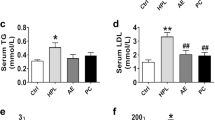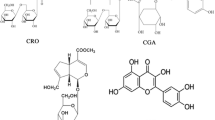Abstract
An extract from red ginseng [steamed and dried roots of Panax ginseng C.A. Meyer (RGE)] has been shown to have various actions on physiological functions. The mechanisms by which RGE promotes cholesterol metabolism in the liver are unclear, but RGE decreases the plasma levels of cholesterol. We investigated whether RGE affected the mRNA expression of cholesterol metabolism-related proteins such as cytochrome P450 (CYP)7A1 and bile salt export pump (BSEP) in the liver in hypercholesterolemic rats and rat primary hepatocytes. In-vivo studies showed the upregulation of CYP7A1 mRNA in hypercholesterolemic rats treated with RGE. Treatment with RGE exhibited decreased ratios of low-density lipoprotein-cholesterol to high-density lipoprotein-cholesterol compared with hypercholesterolemia without RGE. In-vitro studies also showed the upregulation of CYP7A1 mRNA and protein levels by the addition of RGE to rat primary hepatocytes. The mRNA levels of BSEP exhibited few changes. The sustained levels of the liver X receptor (LXR) in vivo and the increased levels of LXR in vitro on RGE treatment could be involved in the upregulation of CYP7A1. To clarify the effects of 11 ginsenosides including RGE on the mRNA levels of CYP7A1 and BSEP, we performed in-vitro experiments using rat primary hepatocytes. The ginsenosides Ro, Rg3, Re, Rg1, and Rg2 exhibited increased mRNA levels of CYP7A1. These results suggest that several ginsenosides including RGE promoted cholesterol metabolism due to upregulation of CYP7A1.





Similar content being viewed by others
References
Yamamoto M, Kumagai A, Yamamura Y (1983) Plasma lipid-lowering action of ginseng saponins and mechanism of the action. Am J Chin Med 11:84–87
Cui X, Sakaguchi T, Ishizuka D, Tsukada K, Hatakeyama K (1998) Orally administered ginseng extract reduces serum total cholesterol and triglycerides that induce fatty liver in 66 % hepatectomized rats. J Int Med Res 26:181–187
Kim SH, Park KS (2003) Effects of Panax ginseng extract on lipid metabolism in humans. Pharmacol Res 48:511–513
Ji W, Gong BQ (2007) Hypolipidemic effects and mechanisms of Panax notoginseng on lipid profile in hyperlipidemic rats. J Ethnopharmacol 113:318–324
Hwang SY, Son DJ, Kim IW, Kim DM, Sohn SH, Lee JJ, Kim SK (2008) Korean red ginseng attenuates hypercholesterolemia-enhanced platelet aggregation through suppression of diacylglycerol liberation in high-cholesterol-diet-fed rabbits. Phytother Res 22:778–783
Song YB, An YR, Kim SJ, Park HW, Jung JW, Kyung JS, Hwang SY, Kim YS (2012) Lipid metabolic effect of Korean red ginseng extract in mice fed on a high-fat diet. J Sci Food Agric 92:388–396
Fernandez C, Lobo MV, Gomez-Coronado D, Lasuncion MA (2004) Cholesterol is essential for mitosis progression and its deficiency induces polyploidy cell formation. Exp Cell Res 300:109–120
Fernandez C, Martin M, Gomez-Coronado D, Lasuncion MA (2005) Effects of distal cholesterol biosynthesis inhibitors on cell proliferation and cell cycle progression. J Lipid Res 46:920–929
Imamura T, Doi Y, Arima H, Yonemoto K, Hata J, Kubo M, Tanizaki Y, Ibayashi S, Iida M, Kiyohara Y (2009) LDL cholesterol and the development of stroke subtypes and coronary heart disease in a general Japanese population: the Hisayama study. Stroke 40:382–388
Baigent C, Keech A, Kearney PM, Blackwell L, Buck G, Pollicino C, Kirby A, Sourjina T, Peto R, Collins R, Simes R (2005) Efficacy and safety of cholesterol-lowering treatment: prospective meta-analysis of data from 90,056 participants in 14 randomised trials of statins. Lancet 366:1267–1278
Marti-Fabregas J, Gomis M, Arboix A, Aleu A, Pagonabarraga J, Belvis R, Cocho D, Roguer J, Rodriguez A, Garcia MD, Molina-Porcel L, Diaz-Manera J, MartiVilalta JL (2004) Favorable outcome of ischemic stroke in patients pretreated with statins. Stroke 35:1117–1121
Elkind MS, Flint AC, Sciacca RR, Sacco RL (2005) Lipid-lowering agent use at ischemic stroke onset is associated with decreased mortality. Neurology 65:253–258
Myant NB, Mitropoulos KA (1977) Cholesterol 7 alpha-hydroxylase. J Lipid Res 18:135–153
Jelinek DF, Andersson S, Slaughter CA, Russell DW (1990) Cloning and regulation of cholesterol 7 alpha-hydroxylase, the rate-limiting enzyme in bile acid biosynthesis. J Biol Chem 265:8190–8197
Redinger RN (2003) The coming of age of our understanding of the enterohepatic circulation of bile salts. Am J Surg 185:168–172
Jansen PL, Strautnieks SS, Jacquemin E, Hadchouel M, Sokal EM, Hooiveld GJ, Koning JH, De Jager-Krikken A, Kuipers F, Stellaard F, Bijleveld CM, Gouw A, Van Goor H, Thompson RJ, Muller M (1999) Hepatocanalicular bile salt export pump deficiency in patients with progressive familial intrahepatic cholestasis. Gastroenterology 117:1370–1379
Akita H, Suzuki H, Ito K, Kinoshita S, Sato N, Takikawa H, Sugiyama Y (2001) Characterization of bile acid transport mediated by multidrug resistance associated protein 2 and bile salt export pump. Biochim Biophys Acta 1511:7–16
Honkakoski P, Zelko I, Sueyoshi T, Negishi M (1998) The nuclear orphan receptor CAR-retinoid X receptor heterodimer activates the phenobarbital-responsive enhancer module of the CYP2B gene. Mol Cell Biol 18:5652–5658
Kliewer SA, Moore JT, Wade L, Staudinger JL, Watson MA, Jones SA, McKee DD, Oliver BB, Willson TM, Zetterstrom RH, Perlmann T, Lehmann JM (1998) An orphan nuclear receptor activated by pregnanes defines a novel steroid signaling pathway. Cell 92:73–82
Waxman DJ (1999) P450 gene induction by structurally diverse xenochemicals: central role of nuclear receptors CAR, PXR, and PPAR. Arch Biochem Biophys 369:11–23
Niesor EJ, Flach J, Lopes-Antoni I, Perez A, Bentzen CL (2001) The nuclear receptors FXR and LXRalpha: potential targets for the development of drugs affecting lipid metabolism and neoplastic diseases. Curr Pharm Des 7:231–259
Chiang JY, Kimmel R, Stroup D (2001) Regulation of cholesterol 7 alpha-hydroxylase gene (CYP7A1) transcription by the liver orphan receptor (LXRalpha). Gene 262:257–265
Wang J, Einarsson C, Murphy C, Parini P, Bjorkhem I, Gafvels M, Eggertsen G (2006) Studies on LXR-and FXR-mediated effects on cholesterol homeostasis in normal and cholic acid-depleted mice. J Lipid Res 47:421–430
Kitagawa I, Yoshikawa M, Yoshihara M, Hayashi T, Taniyama T (1983) Chemical studies on crude drug precession. I. On the constituents of Ginseng Radix Rubra. Yakugaku Zasshi 103:612–622
Samukawa K, Yamashita H, Matsuda H, Kubo M (1995) Simultaneous analysis of saponins in Ginseng Radix by high performance liquid chromatography. Chem Pharm Bull 43:137–141
Samukawa K, Yamashita H, Matsuda H, Kubo M (1995) Simultaneous analysis of ginsenosides of various Ginseng Radix by HPLC. Yakugaku Zasshi 115:241–249
Seglen PO (1976) Preparation of isolated rat liver cells. Methods Cell Biol 13:29–83
Kawase A, Fujii A, Negoro M, Akai R, Ishikubo M, Komura H, Iwaki M (2008) Differences in cytochrome P450 and nuclear receptor mRNA levels in liver and small intestine between SD and DA rats. Drug Metab Pharmacokinet 23:196–206
Pullinger CR, Eng C, Salen G, Shefer S, Batta AK, Erickson SK, Verhagen A, Rivera CR, Mulvihill SJ, Malloy MJ, Kane JP (2002) Human cholesterol 7alpha-hydroxylase (CYP7A1) deficiency has a hypercholesterolemic phenotype. J Clin Invest 110:109–117
Del Bas JM, Fernandez-Larrea J, Blay M, Ardevol A, Salvado MJ, Arola L, Blade C (2005) Grape seed procyanidins improve atherosclerotic risk index and induce liver CYP7A1 and SHP expression in healthy rats. FASEB J 19:479–481
Yamamoto M, Uemura T, Nakama S, Uemiya M, Kumagai A (1983) Serum HDL-cholesterol-increasing and fatty liver-improving actions of Panax ginseng in high cholesterol diet-fed rats with clinical effect on hyperlipidemia in man. Am J Chin Med 11:96–101
Peet DJ, Turley SD, Ma W, Janowski BA, Lobaccaro JM, Hammer RE, Mangelsdorf DJ (1998) Cholesterol and bile acid metabolism are impaired in mice lacking the nuclear oxysterol receptor LXR alpha. Cell 93:693–704
Schultz JR, Tu H, Luk A, Repa JJ, Medina JC, Li L, Schwendner S, Wang S, Thoolen M, Mangelsdorf DJ, Lustig KD, Shan B (2000) Role of LXRs in control of lipogenesis. Genes Dev 14:2831–2838
Gupta S, Pandak WM, Hylemon PB (2002) LXR alpha is the dominant regulator of CYP7A1 transcription. Biochem Biophys Res Commun 293:338–343
Maglich JM, Stoltz CM, Goodwin B, Hawkins-Brown D, Moore JT, Kliewer SA (2002) Nuclear pregnane x receptor and constitutive androstane receptor regulate overlapping but distinct sets of genes involved in xenobiotic detoxification. Mol Pharmacol 62:638–646
Sinal CJ, Tohkin M, Miyata M, Ward JM, Lambert G, Gonzalez FJ (2000) Targeted disruption of the nuclear receptor FXR/BAR impairs bile acid and lipid homeostasis. Cell 102:731–744
Ananthanarayanan M, Balsubramanian N, Makishima M, Mangelsdorf DJ (2001) Human bile salt export pump promoter is transactivated by the farnesoid X receptor/bile acid receptor. J Biol Chem 276:28857–28865
Plass JR, Mol O, Heegsma J, Geuken M, Faber KN, Jansen PL, Muller M (2002) Farnesoid X receptor and bile salts are involved in transcriptional regulation of the gene encoding the human bile salt export pump. Hepatology 35:589–596
Brown MS, Goldstein JL (1997) The SREBP pathway: regulation of cholesterol metabolism by proteolysis of a membrane-bound transcription factor. Cell 89:331–340
Horton JD, Shimomura I, Brown MS, Hammer RE, Goldstein JL, Shimano H (1998) Activation of cholesterol synthesis in preference to fatty acid synthesis in liver and adipose tissue of transgenic mice overproducing sterol regulatory element-binding protein-2. J Clin Invest 101:2331–2339
Shimano H, Horton JD, Hammer RE, Shimomura I, Brown MS, Goldstein JL (1996) Overproduction of cholesterol and fatty acids causes massive liver enlargement in transgenic mice expressing truncated SREBP-1a. J Clin Invest 98:1575–1584
Inagaki T, Lin VY, Goetz R, Mohammadi M, Mangelsdorf DJ, Kliewer SA (2008) Inhibition of growth hormone signaling by the fasting-induced hormone FGF21. Cell Metab 8:77–83
Quan LH, Min JW, Yang DU, Kim YJ, Yang DC (2012) Enzymatic biotransformation of ginsenoside Rb1 to 20(S)-Rg3 by recombinant β-glucosidase from Microbacterium esteraromaticum. Appl Microbiol Biotechnol 94:377–384
Hasegawa H, Sung JH, Matsumiya S, Uchiyama M (1996) Main ginseng saponin metabolites formed by intestinal bacteria. Planta Med 62:453–457
Akao T, Kida H, Kanaoka M, Hattori M, Kobashi K (1998) Intestinal bacterial hydrolysis is required for the appearance of compound K in rat plasma after oral administration of ginsenoside Rb1 from Panax ginseng. J Pharma Pharmacol 50:1155–1160
Wakabayashi C, Murakami K, Hasegawa H, Murata J, Saiki I (1998) An intestinal bacterial metabolite of ginseng protopanaxadiol saponins has the ability to induce apoptosis in tumor cells. Biochem Biophys Res Commun 246:725–730
Bae EA, Park SY, Kim DH (2000) Constitutive beta-glucosidases hydrolyzing ginsenoside Rb1 and Rb2 from human intestinal bacteria. Biol Pharm Bull 23:1481–1485
Tawab MA, Bahr U, Karas M, Wurglics M, Schubert-Zsilavecz M (2003) Degradation of ginsenosides in humans after oral administration. Drug Metab Dispos 31:1065–1071
Hasegawa H, Uchiyama M (1998) Antimetastatic efficacy of orally administered ginsenoside Rb1 in dependence on intestinal bacterial hydrolyzing potential and significance of treatment with an active bacterial metabolite. Planta Med 64:696–700
Lee SJ, Ko WG, Kim JH, Sung JH, Moon CK, Lee BH (2000) Induction of apoptosis by a novel intestinal metabolite of ginseng saponin via cytochrome c-mediated activation of caspase-3 protease. Biochem Pharmacol 60:677–685
Bae EA, Choo MK, Park EK, Park SY, Shin HY, Kim DH (2002) Metabolism of ginsenoside Rc by human intestinal bacteria and its related antiallergic activity. Biol Pharm Bull 25:743–747
Choo MK, Park EK, Han MJ, Kim DH (2003) Antiallergic activity of ginseng and its ginsenosides. Planta Med 69:518–522
Xie HT, Wang GJ, Chen M, Jiang XL, Li H, Lv H, Huang CR, Wang R, Roberts M (2005) Uptake and metabolism of ginsenoside Rh2 and its aglycon protopanaxadiol by Caco-2 cells. Biol Pharm Bull 28:383–386
Han M, Fang XL (2006) Difference in oral absorption of ginsenoside Rg1 between in vitro and in vivo models. Acta Pharmacol Sin 27:499–505
Han M, Sha X, Wu Y, Fang X (2006) Oral absorption of ginsenoside Rb1 using in vitro and in vivo models. Planta Med 72:398–404
Xiong J, Sun M, Guo J, Huang L, Wang S, Meng B, Ping Q (2009) Active absorption of ginsenoside Rg1 in vitro and in vivo: the role of sodium-dependent glucose co-transporter 1. J Pharm Pharmacol 61:381–386
Conflict of interest
The authors report no conflicts of interest.
Author information
Authors and Affiliations
Corresponding author
Rights and permissions
About this article
Cite this article
Kawase, A., Yamada, A., Gamou, Y. et al. Increased effects of ginsenosides on the expression of cholesterol 7α-hydroxylase but not the bile salt export pump are involved in cholesterol metabolism. J Nat Med 67, 545–553 (2013). https://doi.org/10.1007/s11418-012-0713-4
Received:
Accepted:
Published:
Issue Date:
DOI: https://doi.org/10.1007/s11418-012-0713-4




